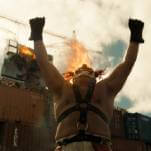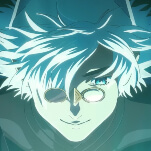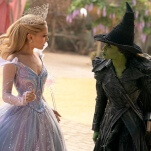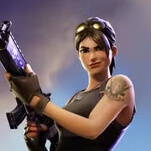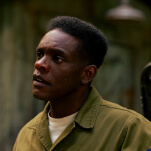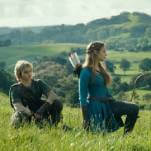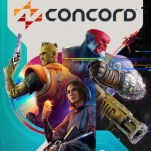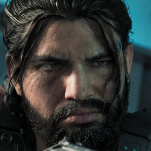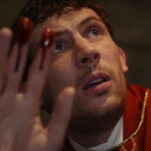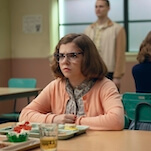Nobody dies in the comics—nobody important, anyway. So it’s no surprise that fans greeted the news of Bruce Wayne’s expiration with skepticism. After all, anybody who can walk away from a broken spine and survive two Joel Schumacher movies probably won’t stay gone for long. Starting in this month’s Batman #686 and concluding next month in Detective Comics #853, “Whatever Happened To The Caped Crusader?” has Neil Gaiman writing and Andy Kubert drawing a eulogy for the man who was Batman; the title is a reference to the last pre-Crisis Superman story, by Alan Moore. And like Moore’s work, “Crusader” attempts to provide a fitting capstone for the legacy of an icon. All the big names in Gotham have come to pay their respects to the costumed corpse, but while the faces may be familiar, something isn’t right. Part one features Selina Kyle and Alfred Pennyworth telling two very different tales of the Bat, and there are indications of more metatextual trickery ahead; it’s Gaiman doing what he does best, ably assisted by Kubert’s clean, retro-modernist style. If every comic sales stunt generated this kind of creativity, readers might look on them more kindly… A
Comics had produced a fair number of talented writers prior to Alan Moore—including a few who specialized in superheroes—but with Moore’s second issue as the writer of Saga Of The Swamp Thing, he expanded American comic fans’ understanding of what was possible in the medium. Borrowing a horrific premise and clever structure from classic EC fare, the story “The Anatomy Lesson” rewrites Swamp Thing’s origin into something grimmer and more despairing, while throwing in a twist ending, florid narration, and the kind of poetic grace notes that mainstream comics had rarely seen. The hardcover collection Saga Of The Swamp Thing: Book One (Vertigo) repackages the existing trade paperback of Moore’s first Swamp Thing stories, adding a new introduction by Len Wein and throwing in—for the first time—the none-too-thrilling deck-clearing story “Loose Ends,” which sets the stage for “The Anatomy Lesson” and what comes afterward. As for those initial post-“Anatomy” tales, by and large they aren’t up to the standard that Moore would later set, both with this series and beyond. The art team of Stephen Bissette and John Totleben were still finding the right look for the book in the early going, and Moore was still enjoying making gooey monster-fights into sophisticated gothic entertainment. Eventually he’d make Swamp Thing more philosophical, more political, and deeper emotionally. But the cockiness of the stories in this first volume still makes them feel just as fresh some 25 years later. Moore was treating adventure comics the way he treated Swamp Thing himself: as a lumbering creature that had been misinterpreted and misused, but could, when cared for properly, actually bear fruit… A-
Much like the recent graphic novel Jumpscars did with Jumper, the six-issue miniseries Push (Wildstorm) serves as a prequel to the recent gritty superheroes movie of the same name. Like Jumpscars, the Push comic provides an alternate point of view—where the film focuses largely on a bunch of scruffy rebels fighting the monolithic government agency Division, the comic looks into a series of formative events at Division, including the early days of the film’s baddie, played by Djimon Hounsou. It’s inessential, but hired-hand writers Adam Freeman and Marc Bernardin make a good effort at making it interesting by focusing on internal politics and caper-ish adventures, as a Division agent runs a series of operations, is repeatedly betrayed by his superiors, and starts unraveling a series of plots that require him as the fall guy. Problem is, by halfway through the story, it’s become a pretty generic story, given flavor largely by the world-specific types of psychics (pushers, watchers, phasers, and so forth), and most of the characters have failed to develop personalities, unfortunately including the protagonist. They’re jobs, not people. Which makes it hard to care about all the convoluted backstabbing going on… C+
Pascal Blanchet follows the stunning White Rapids with Baloney (Drawn & Quarterly), another experiment in combining elegant commercial design with simple storytelling. While White Rapids rocked to the beat of big-band music, Baloney rolls to the dramatic melancholy of Eastern European classical music. (Blanchet even notes the instruments he imagines scoring each of the book’s three chapters.) The story—about a malicious duke and a tragic butcher—feels too abrupt, as a natural byproduct of Blanchet’s each-page-is-a-panel style. But every illustration in Baloney is a singular, soulful work of art, conveying whimsy, action, and deep, deep sorrow in just a few perfectly executed lines… B+
In addition to Baloney, Drawn & Quarterly is offering two more short-but-powerful books newly translated into English. Pascal Girard’s Nicolas and Diane Obomsawin’s Kaspar both deal with the enduring mysteries of life and death via simplified cartooning and deadpan wit. Nicolas is an autobiographical sketch, recounting Girard’s memories of dealing with his brother’s death. Nicolas died when Girard was too young to know how to process his absence, and over the years, the cartoonist has swung from feeling the loss to feeling guilty and angry that he doesn’t feel it more. Girard’s elliptical journey from youth to adulthood—always under the cloud of what happened when he was a boy—makes for a quietly moving read. As for Kaspar, it recounts the famous story of Kaspar Hauser, a 19th-century German boy imprisoned in a featureless room until his mid-teens, at which point he was released into the world, only to become a social curiosity. Obomsawin relies heavily on Hauser’s own feelings, getting into the head of someone who relished subtle sensations, and was frightened by strong ones. Kaspar is a sweet, sad book, made more effective by Obomsawin’s childlike drawings and lack of cynicism… Both: A-
The same refreshing sweetness tinges Shaun Tan’s strange fables in the illustrated book Tales From Outer Suburbia (Arthur A. Levine), a collection of haunting vignettes reminiscent tonally of Chris Van Allsburg’s The Mysteries Of Harris Burdick, but with stories and color instead of elliptical captions and black-and-white. It’s meant as a children’s book, but it’s the kind of enjoyably weird, off-kilter look at the world that can be enjoyed by adults—or adults and their kids together—in equal measure. Some of Tan’s short stories center on mysterious figures, like the deep-sea diver wandering around a city, or a water buffalo that points in the direction of obscure answers to burning problems. Others focus on odd situations: the house with a hidden country between its floors, a giant machine with a creepy purpose. Still others make up rituals, or beliefs, or in one case, the ethereally beautiful life cycle of discarded poetry. Either way, the stories feel dreamlike, in a very specific sense: They recreate the world entirely in unexpected little ways, but present all the changes as normal and acceptable, yet prone to prompting vague misgivings. And his illustrations, in a variety of styles, from little sketchy insets to a series of full-pagers standing in for the middle part of a text story—are gorgeous, whimsical, and wistful, even at their most positive. Readers addicted to the Flight series shouldn’t miss out on this similarly lovely bit of beauty… A
The Star Wars prequels never skimped when it came to world-building. That was part of the problem; so much time was spent on new aliens and environments that the movies felt less like narratives than like encyclopedia entries. Star Wars Omnibus: Rise Of The Sith (Dark Horse) collects a handful of previously published Dark Horse Comics minis, each of which gets some mileage out of all that exposition. Most of the stories focus on familiar Jedi Council faces like Qui-Gon Jinn and Mace Windu as they struggle to bring order to the galaxy, but the highlight is the final entry, a universe-spanning massacre which offers some satisfaction to all those disappointed by Darth Maul’s abrupt exit in Phantom Menace. The art through the collection ranges from solid to sub-Liefeld, and the writing rarely surprises, but it all moves at a brisk pace, and none of the stories outlast their welcome. With the small satisfaction they offer, the writers and artists here have mastered the one thing that Lucas seemed to miss: Setting the stage is important, but in the end, it’s all about the lightsabers… B-
Unfortunately, Bang! Tango (Vertigo) isn’t a comic-book biography of the late-‘80s glam-rock outfit. Just as unfortunately, in spite of the credits, it isn’t a Howard Chaykin production; he’s only responsible for the covers, though his sensibilities are much better suited to the story and art than the actual creative team’s. The new six-issue miniseries from writer Joe Kelly (Action Comics) and artist Adrian Sibar (Batgirl) follows the adventure of a reformed mobster who tries to start a new life as a professional dancer—a quest complicated by the reappearance of a femme fatale from his past. Kelly’s sense of humor is serviceable enough, but it isn’t as jagged as Chaykin’s sexy stuff, nor as absurd as the story demands, and Sibar’s art, while promising, doesn’t quite fit the material, especially since no one draws this sort of lantern-jawed-stud/black-hearted-floozy material like Chaykin. Even taken on its own merits, Kelly’s script can’t live up to the premise’s promising goofiness. A fun twist at the end of issue #2 is promising enough to keep readers around for the rest of the series, but overall, it’s a bit of a disappointment… B-
Koren Shadmi’s graphic novel In The Flesh(Villard) has one of those rare covers that’s less about marketing than about frankly establishing the book’s contents: It’s an image of a staring, haunted-looking woman, whose long black hair winds into the room of a man, binding and blinding him. The image isn’t representative of the simpler black-and-white art within, but all the short comics stories in the anthology are similarly about people uncomfortable and obsessively caught up with each other, whether they’re on a first date, fixating over a first fuck, being courted by a would-be lover with evil intentions, or dealing with a family member whose motives are obscure. Shadmi focuses on visual metaphors that are sometimes obscure and sometimes blatantly obvious—the intent behind the story about two people on a date with bags over their heads is obvious, but that doesn’t blunt the impact of the moment when one of the two dares to remove the bag. The woman who becomes a frantic glutton after being hit by a car—or the one named Antoinette who carries her head around under her arm—are distinctly weirder, but their stories of disassociation, detachment, and animal pleasures are similarly raw and sad, and full of sudden profound ugliness when they give into their needs. It’s an eerie book, maybe more clever than profound, but still awfully damn clever… B
Starting in the mid-’70s, a professional book indexer and obsessive Marvel superfan named George Olshevsky published (with late independent publisher Pacific Comics) something called the Official Marvel Index. A labor of love for Olshevsky (who, at the time, owned every Marvel comic published from 1962 to 1976), the Index contained creative teams, page information, publication dates, brief plot summaries, and other key data for every book the company put out. Now, more than 30 years later, Marvel has put out a new version called Official Index To The Marvel Universe, this time compiled and written by their own people and published in standard comics format. The original, fan-published Index was a wonderful geek artifact, and a useful tool for collectors; the new version is a largely inexplicable, shoddily assembled title for completists that seems to exist for no other reason than to turn a buck. The design is purely functional, the writing is uninteresting, and by this point, it’s such a massive undertaking that it’s likely to be abandoned before it’s ever finished. Beyond that, unlike in Olshevsky’s day, all this information is now available with relative ease over the Internet. The target audience for this is the most recidivist of Marvel zombies; anyone else shouldn’t even bother… D+
The “Missed Connections” ads in free alt-weeklies, newspaper classifieds, and websites like Cragislist are a real love-‘em-or-hate-‘em phenomenon. Born of a sort of whimsical urban loneliness crashed headlong into modern media saturation, they have fans who find them delightful and sometimes heartbreaking, and detractors who find them cloying, intrusive, and lame. Whatever the case, they’ve developed a curious language and poetry all their own, which is the primary motivation behind I Saw You: Comics Inspired By Real-Life Missed Connections(Three Rivers Press). Author Julia Wertz (who is also responsible for a comics collection unpromisingly called The Fart Party) assembled the collection, with the support of an artists’ roster which includes a few ringers (Peter Bagge, Jeffrey Brown, Keith Knight, and Emily Flake among them) and a ton of unknowns, none of whom are likely to make their reputations based on this book. Occasionally, the entries are extremely strange, and those are the most worthwhile ones, but for the most part, only those who share Wertz’s obvious enthusiasm for missed-connections ads will care much about the book… C+
James Kochalka continues to produce a four-panel illustrated diary at a rate of roughly one comic a day, posting them online at americanelf.com. Then every few years, Top Shelf collects them all for print. The latest volume is American Elf: The Collected Sketchbook Diaries Of James Kochalka Book Three, which covers January 1, 2006 to December 31, 2007. It’s an eventful couple of years, during which his wife Amy became pregnant and miscarried, then conceived and gave birth to their second son, Oliver. The early years of American Elf were fractious and random, with Kochalka and Amy frequently fighting, but largely lying around observing each other and the world around them; kids seem to have made them more active, or at least given Kochalka a regular source of inspiration. One of the little joys of volume three is watching their first son, Eli, develop from a pidgin-speaking toddler into an impressively creative kid whom Kochalka takes obvious delight in encouraging. Another is the way the days seem to flow by in a series of non-critical but generally funny or bizarro moments. More and more, American Elf resembles a more colorful, less dense take on Matt Groening’s “Will and Abe” strips, in which he gracefully stepped back and let his kids’ endless imaginations and inadvertent hilariousness stand in for his own, though in both cases, the fathers’ senses of humor clearly influence the sons’, shaping what may be the next generation of creators… B+
Corinna Sara Bechko lays out a compellingly odd premise in the graphic novel Heathentown (Shadowline): After visiting grad student Kit is killed in a local uprising in Chad, her friend (and apparently lover) Anna takes her body home. But shortly after the funeral, she sees Kit walking around. Investigating, she winds up in legal trouble as well as physical danger, as she digs up some weird local secrets. The story vaguely recalls the ghoulish, creeping horror of classic EC Comics, though without nearly so much moralizing, but exactly what’s going on gets a little muddy, as Bechko spends far more time on a series of exhausting, grimy action scenes than on exploring the central mystery or its aftermath. As Anna repeatedly escapes, flees, and is recaptured, Heathentown starts to feel like the movie Descent: an endless series of shocks and horrors that leave readers as wrung-out as the protagonist. It’s all done reasonably well, particularly thanks to Gabriel Hardman’s sharply detailed black-and-white art, which delineates each scrape and nick on Anna’s battered skin. But it leaves a lot of frustrating questions at the end, and few of them seem intended… B
Fans of French collaborators Joann Sfar and Lewis Trondheim will find a lot familiar about Hubert & Kerascoet’s graphic novel Miss Don’t Touch Me(NBM), a ’30s period piece about a naïve, virginal girl who goes undercover as a dominatrix in a high-end brothel to avenge her sister’s murder at the hands of a notorious serial killer. The plot sounds salacious, but writer-colorist Hubert and artists Kerascoet (the pseudonym of a husband-and-wife team who’ve also worked on Sfar and Trondheim’s Dungeon books) pay out the story exactly like Sfar and Trondheim would—as a series of little revelations and tangled developments that concentrate on small moments between characters, and don’t go anywhere in a hurry. Hubert takes the time to establish the world of ’30s Paris and of the brothel in particular, and the illustrations, as in the Dungeon books, use a loose, cartoony style, but pack the panels in so small and tiny that the overall effect is surprisingly dense and rich. Fans of the likes of The Rabbi’s Cat might enjoy this, though it’s less philosophical and more of a thriller-mystery, albeit without the breathless pace the genre usually demands… B+
In the latest big, beautiful Library of American Comics collection, Harold Gray's Little Orphan Annie Volume Two (IDW), our spunky redhead suffers the usual melodramatic indignities: kidnapped by thieves, returned to the orphans' home, lost at sea. And all because Daddy Warbucks can't arrange his affairs well enough to provide for her when he's out of town on business! But the real action in this thoroughly wonderful compendium is in the minutiae of everyday tasks Annie takes on to survive: selling newspapers, running a restaurant, taking in laundry. Page after page records her struggle to master the rules of these mundane but nevertheless complex occupations. The glory of Little Orphan Annie is the way creator Harold Gray wears his heart and his politics on his sleeve, caring more about whether organizing into cooperatives will save the family farm than about the gangsters and plutocrats that are always gunning for our heroes. This book is more than a page-turning melodrama; it's a rare peek into the daily concerns of a country slipping into Depression, and a redeeming gift of unwavering innocence. A

